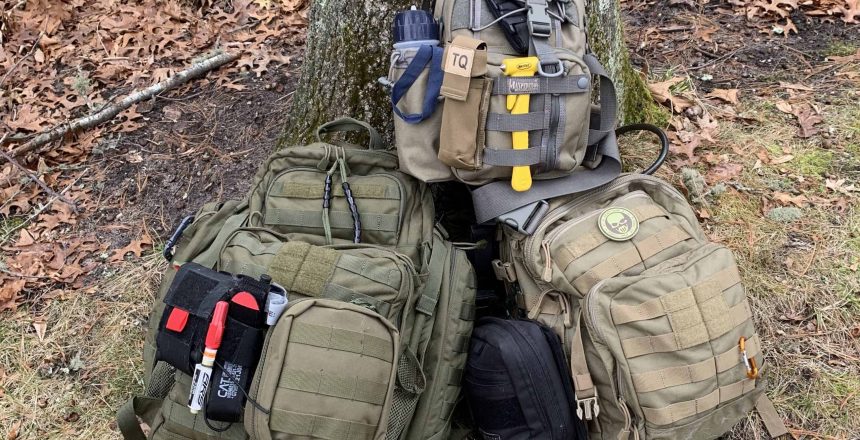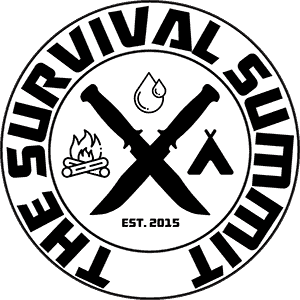Bugout Bag & Training Ideas

There are many types of “Bugout” bags. There is the simple get home quick pack which may only consist of a few items that would be enough to get you home or to your bugout location, and that kits contents, like nearly all others, would depend on a lot of different factors. What your average distance from home is on any given day, the time of year, geographical landscape, urban vs. rural, and sometimes overlooked is your physical conditioning. A get home pack is meant to have the essentials so you can travel fast and light.
The sample bugout bag below is what would be used as a full bugout bag that you would be able to travel with for an indefinite amount of time, depending on your skill level and the conditions you’re traveling in. In the event of a major disaster, especially one that could put us on the brink of collapse, you will not have time to train after-the-fact.
Now is the time to start training more frequently, or to begin training if you haven’t already. You will only perform to your level of training, and you are likely not John Wick or Bear Grylls.
Sample Bugout Bag List
- 5.11 Rush 12, 24, or 72 Backpack, or 5.11 Covrt 18 backpack (Covrt 18 preferred for travel in urban areas)
- Camelbak Water bladder for the backpack
- Grayl Geo Press Water Filter. Good for bacteria and viruses
- Sawyer Mini Water Filter (good for 100K gallons if kept clean)
- Single wall construction stainless steel canteen or water bottle
- At least 100′ 550 Paracord
- Fire Starters (ferro rod/striker), camp stove, candles (recommend ½” X 6” Ferro Rod)
- Lightweight tinder such as fat wood
- Packable fishing kit, traps, snare wire, etc.
- (2) Emerg. Space Blankets. Lightweight and easy to carry in your bugout bag
- Snugpak Patrol Poncho or Military Poncho (Mil Surplus if it’s in decent shape)
- Quality bushcraft knife w/scandi grind and 90-degree spine for ferro rod strikes
- Hults Bruk Swedish Axe or hatchet
- Suunto Compass
- Quality standard first-aid kit (remember to include moleskins)
- Quality Trauma Kit (recommend North American Rescue)
- Nitecore P12GTS Flashlight (extra 18650 batteries) Multi-levels, long-life
- Nitecore also makes flashlights that take AA rechargeable batteries.
- Small solar recharger for flashlights and electronic devices, such as GPS.
- Entrenching Shovel (Mil. Surplus, SOG, Cold Steel, etc.)
- Silky Super Excel saw – Don’t skimp on this, buy Silky!
- E&E Gear: Cuff Keys, Shims, Pick Set, bump keys, Kevlar cordage
- High-quality sleeping bag or bivy sack
- Emergency food rations (high-calorie bars/blocks) SOS brand is decent.
- Hat, coat, blanket, gloves, socks (100% wool) Depending on what season/location.
- Tarp for quick shelters
- Last, but not least, your rifle, sidearm, and spare magazines.
A few Training Ideas
Survival training: The best gear in the world will be useless if you are not skilled enough to use it. If you can’t afford live training, watch our videos and then go out and practice as often as you can. You’d be surprised how much you can teach yourself and your family. Most importantly, don’t ever just take gear advice from someone else. TEST every piece of gear yourself! Even if you’re using gear recommended by the world’s top experts, what if there is a manufacturer defect and your gear fails when you need it most? Always test your gear and be sure it’s up to par.
Physical Training: Running/Jogging/Brisk walking – Once you’re comfortable going a few miles, start training with your backpack on. Find harder terrain once your body is used to flat surfaces, such as hills, rocky terrain, and mountains. When it comes to strength training, focus on functional strength vs. bodybuilding. Workouts such as the ones used in cross-fit are more relevant to get you prepared to push your body to the limits in terms of strength and endurance.
Self-Defense Training: Practice Jiu-jitsu as well as stand-up fighting, such as boxing or Muay Thai. If you believe you can just use “Glock-Fu” in any situation, you will be very disappointed when you get into an actual fight for your life. In the event of societal breakdown or collapse, you could be going from permissive environments to semi-permissive environments very quickly. The amount of time you spend training will have a lot to do with determining how long you and your family survive.
Firearms Training: Spend a lot more money on firearms training than you do firearms, ammo, and gear. A $3K firearm is worthless if you can’t shoot it well, consistently. Dry fire and practice your draw daily, for at least 15 minutes. There are plenty of ways to train without live fire to save on ammo and range fees, but you must practice live fire as often as you can. Our newest film, FIREARMED® is a great resource.
Medical Training: Go take a TCCC or TECC trauma course. Take a wilderness medical course if you’re able as well. We start filming our Wilderness medical course with Joshua Enyart, AKA the Gray Bearded Green Beret, tomorrow! We’re hoping this new film will be available by mid-late March if all goes well. Survival Summit also carries a great selection of trauma gear, Made in the USA.
Plant identification: Study plant identification to learn more about what’s edible vs. poisonous, as well as the best medicinal plants. You’ll need to understand how to process, prepare, and cook plants and animals in the wild, as well as how to smoke meats for long-time survival.
Looking for gear that we don’t carry yet? Feel free to shoot us an email as we can likely find almost anything you’re looking for or at least point you in the right direction as to where to buy it. Your bugout bag is a very important piece of equipment, and we are here to help. jesse@thesurvivalsummit.com
Newest Blog: Bug in VS. SHTF Bug Out
